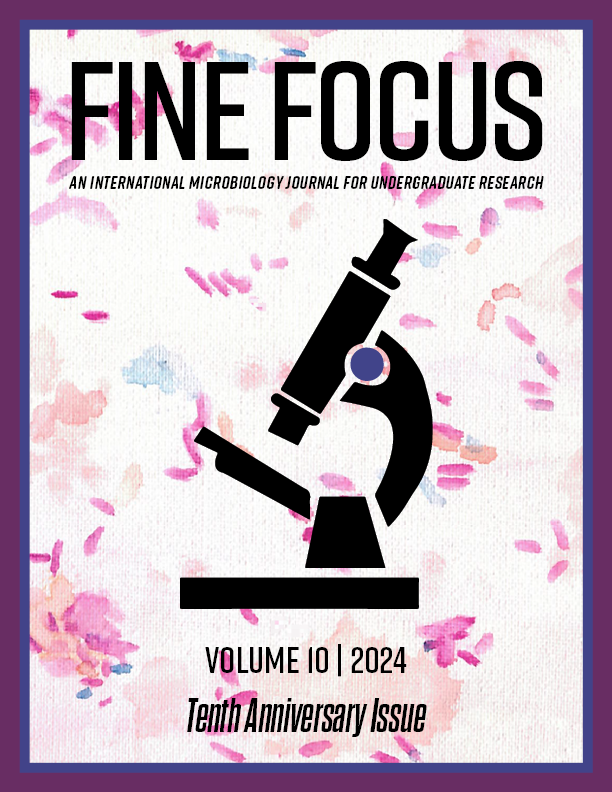Polymicrobial Conditions Affect Antibiotic Susceptibility in Clinically Relevant Bacterial Species
DOI:
https://doi.org/10.33043/FF.10.1.74-89Keywords:
antimicrobial susceptibility, minimum inhibitory concentration (MIC), antimicrobial susceptibility testing (AST), polymicrobial, wound, diagnostic, synergismAbstract
Chronic wounds, defined as those which remain open and inflamed for greater than six weeks, are a major area of clinical concern. Resulting in thousands of amputations per year and billions of dollars spent globally in treatment, chronic wounds are notoriously difficult to successfully treat. Two hallmarks of chronic wounds are that they are thought to harbor biofilm-associated bacteria and tend to be polymicrobial. While the research literature has repeatedly demonstrated the effects of biofilms on wound persistence and the changes to the efficacy of antibiotics, few studies have demonstrated what effect the polymicrobial condition has on the antibiotic tolerance of bacteria. To further explore this, four species of clinically relevant wound pathogens (Pseudomonas aeruginosa, Acinetobacter baumanii, Staphylococcus aureus, and Enterococcus faecalis) were tested in mono- and polymicrobial conditions using the current gold-standard clinical methods for determining antibiotic susceptibility. Noticeable differences in antibiotic tolerance were observed in the polymicrobial condition, including both increased and decreased susceptibility, depending on the antibiotic used. Our data demonstrate that the current clinical methods used for testing antibiotic susceptibility can generate results that are not representative of the infection environment, which may contribute to treatment failure and persistence of polymicrobial infections.
Downloads
References
Järbrink, K., Ni, G., Sönnergren, H., Schmidtchen, A., Pang, C., Bajpai, R., & Car, J. (2017). The humanistic and economic burden of chronic wounds: A Protocol for a systematic review. Systematic Reviews, 6(1). https://doi.org/10.1186/s13643-016-0400-8
Nussbaum, S. R., Carter, M. J., Fife, C. E., DaVanzo, J., Haught, R., Nusgart, M., & Cartwright, D. (2018). An economic evaluation of the impact, cost, and Medicare policy implications of chronic nonhealing wounds. Value in Health, 21(1), 27–32. https://doi.org/10.1016/j.jval.2017.07.007
Iheozor-Ejiofor, Z., Newton, K., Dumville, J. C., Costa, M. L., Norman, G., & Bruce, J. (2018). Negative pressure wound therapy for open traumatic wounds. Cochrane Database of Systematic Reviews, 2018(7). https://doi.org/10.1002/14651858.cd012522.pub2
Snyder RJ, Bohn G. Hanft J. et al. (2017). Wound Biofilm: Current Perspectives and Strategies on Biofilm Disruption and Treatments. Wounds,29(6):S1-S17.
Torkington-Stokes, R., Metcalf, D., & Bowler, P. (2016). Management of diabetic foot ulcers: Evaluation of case studies. British Journal of Nursing, 25(15). https://doi.org/10.12968/bjon.2016.25.15.s27
Barrell, K., & Smith, A. G. (2019). Peripheral neuropathy. Medical Clinics of North America, 103(2), 383–397. https://doi.org/10.1016/j.mcna.2018.10.006
Myckatyn, T. M., Cohen, J., & Chole, R. A. (2016). Clarification of the definition of a “biofilm.” Plastic and Reconstructive Surgery, 137(1), 237–238. https://doi.org/10.1097/prs.0000000000001911
Tolker-Nielsen, T. (2015). Biofilm development. Microbiology Spectrum, 3(2). https://doi.org/10.1128/microbiolspec.mb-0001-2014
Arweiler, N. B., & Netuschil, L. (2016). The oral microbiota. Microbiota of the Human Body, 45–60. https://doi.org/10.1007/978-3-319-31248-4_4
Körber, A., Schmid, E. N., Buer, J., Klode, J., Schadendorf, D., & Dissemond, J. (2010). Bacterial colonization of chronic leg ulcers: Current results compared with data 5 years ago in a specialized dermatology department. Journal of the European Academy of Dermatology and Venereology, 1017–1025. https://doi.org/10.1111/j.1468-3083.2010.03570.x
Beaudoin, T., Yau, Y. C., Stapleton, P. J., Gong, Y., Wang, P. W., Guttman, D. S., & Waters, V. (2017). Staphylococcus aureus interaction with pseudomonas aeruginosa biofilm enhances tobramycin resistance. Npj Biofilms and Microbiomes, 3(1). https://doi.org/10.1038/s41522-017-0035-0
Dowd, S. E., Sun, Y., Secor, P. R., Rhoads, D. D., Wolcott, B. M., James, G. A., & Wolcott, R. D. (2008). Survey of bacterial diversity in chronic wounds using pyrosequencing, DGGE, and full ribosome shotgun sequencing. BMC Microbiology, 8(1), 43. https://doi.org/10.1186/1471-2180-8-43
DeLeon, S., Clinton, A., Fowler, H., Everett, J., Horswill, A. R., & Rumbaugh, K. P. (2014). Synergistic interactions of pseudomonas aeruginosa and Staphylococcus aureus in an in vitro wound model. Infection and Immunity, 82(11), 4718–4728. https://doi.org/10.1128/iai.02198-14
Deng, Y.-J., & Wang, S. Y. (2016). Synergistic growth in bacteria depends on substrate complexity. Journal of Microbiology, 54(1), 23–30. https://doi.org/10.1007/s12275-016-5461-9
Korgaonkar, A., Trivedi, U., Rumbaugh, K. P., & Whiteley, M. (2012). Community surveillance enhances pseudomonas aeruginosa virulence during polymicrobial infection. Proceedings of the National Academy of Sciences, 110(3), 1059–1064. https://doi.org/10.1073/pnas.1214550110
Bahamondez-Canas, T. F., Heersema, L. A., & Smyth, H. D. (2019). Current status of in vitro models and assays for susceptibility testing for wound biofilm infections. Biomedicines, 7(2), 34. https://doi.org/10.3390/biomedicines7020034
Citron, D. M., Goldstein, E. J., Merriam, C. V., Lipsky, B. A., & Abramson, M. A. (2007). Bacteriology of moderate-to-severe diabetic foot infections and in vitro activity of antimicrobial agents. Journal of Clinical Microbiology, 45(9), 2819–2828. https://doi.org/10.1128/jcm.00551-07
Estrela, S., & Brown, S. P. (2018). Community interactions and spatial structure shape selection on antibiotic resistant lineages. PLOS Computational Biology, 14(6). https://doi.org/10.1371/journal.pcbi.1006179
Madsen, J. S., Burmølle, M., Hansen, L. H., & Sørensen, S. J. (2012). The interconnection between biofilm formation and horizontal gene transfer. FEMS Immunology & Medical Microbiology, 65(2), 183–195. https://doi.org/10.1111/j.1574-695x.2012.00960.x
Orazi, G., & O’Toole, G. A. (2019). “it takes a village”: Mechanisms underlying antimicrobial recalcitrance of polymicrobial biofilms. Journal of Bacteriology, 202(1). https://doi.org/10.1128/jb.00530-19
Fauvart, M., De Groote, V. N., & Michiels, J. (2011). Role of persister cells in chronic infections: Clinical relevance and perspectives on anti-persister therapies. Journal of Medical Microbiology, 60(6), 699–709. https://doi.org/10.1099/jmm.0.030932-0
Hall, C. W., & Mah, T.-F. (2017). Molecular mechanisms of biofilm-based antibiotic resistance and tolerance in pathogenic bacteria. FEMS Microbiology Reviews, 41(3), 276–301. https://doi.org/10.1093/femsre/fux010
Mah, T.-F. C., & O’Toole, G. A. (2001). Mechanisms of biofilm resistance to antimicrobial agents. Trends in Microbiology, 9(1), 34–39. https://doi.org/10.1016/s0966-842x(00)01913-2
Mottola, C., Matias, C. S., Mendes, J. J., Melo-Cristino, J., Tavares, L., Cavaco-Silva, P., & Oliveira, M. (2016). Susceptibility patterns of Staphylococcus aureus biofilms in diabetic foot infections. BMC Microbiology, 16(1). https://doi.org/10.1186/s12866-016-0737-0
Kosikowska, U., Andrzejczuk, S., Plech, T., & Malm, A. (2016). Inhibitory effect of 1,2,4-triazole-ciprofloxacin hybrids on haemophilus parainfluenzae and haemophilus influenzae biofilm formation in vitro under stationary conditions. Research in Microbiology, 167(8), 647–654. https://doi.org/10.1016/j.resmic.2016.05.009
Velez Perez, A. L., Schmidt-Malan, S. M., Kohner, P. C., Karau, M. J., Greenwood-Quaintance, K. E., & Patel, R. (2016). In vitro activity of ceftolozane/tazobactam against clinical isolates of pseudomonas aeruginosa in the planktonic and biofilm states. Diagnostic Microbiology and Infectious Disease, 85(3), 356–359. https://doi.org/10.1016/j.diagmicrobio.2016.02.014
Er, B., Demirhan, B., Onurdağ, F. K., Özgacar, S. Ö., & Öktem, A. B. (2014). Antimicrobial and antibiofilm effects of selected food preservatives against salmonella spp. isolated from chicken samples. Poultry Science, 93(3), 695–701. https://doi.org/10.3382/ps.2013-03404
Luque-Sastre, L., Fox, E. M., Jordan, K., & Fanning, S. (2018). A comparative study of the susceptibility of listeria species to sanitizer treatments when grown under planktonic and biofilm conditions. Journal of Food Protection, 81(9), 1481–1490. https://doi.org/10.4315/0362-028x.jfp-17-466
Desai, M. (1998). Increasing resistance of planktonic and biofilm cultures of burkholderia cepacia to ciprofloxacin and ceftazidime during exponential growth. Journal of Antimicrobial Chemotherapy, 42(2), 153–160. https://doi.org/10.1093/jac/42.2.153
Pascual, A., de Arellano, E. R., Martínez, L. M., & Perea, E. J. (1993). Effect of polyurethane catheters and bacterial biofilms on the in-vitro activity of antimicrobials against Staphylococcus epidermidis. Journal of Hospital Infection, 24(3), 211–218. https://doi.org/10.1016/0195-6701(93)90050-a
Théraud, M., Bédouin, Y., Guiguen, C., & Gangneux, J.-P. (2004). Efficacy of antiseptics and disinfectants on clinical and environmental yeast isolates in planktonic and biofilm conditions. Journal of Medical Microbiology, 53(10), 1013–1018. https://doi.org/10.1099/jmm.0.05474-0
Martins, K. B., Ferreira, A. M., Pereira, V. C., Pinheiro, L., Oliveira, A. de, & Cunha, M. de. (2019). In vitro effects of antimicrobial agents on planktonic and biofilm forms of Staphylococcus saprophyticus isolated from patients with urinary tract infections. Frontiers in Microbiology, 10. https://doi.org/10.3389/fmicb.2019.00040
Humphries, R. M., Ambler, J., Mitchell, S. L., Castanheira, M., Dingle, T., Hindler, J. A., Koeth, L., Sei, K., Hardy, D., Zimmer, B., Butler-Wu, S., Dien Bard, J., Brasso, B., Shawar, R., Dingle, T., Humphries, R., Sei, K., & Koeth, L. (2018). CLSI methods development and standardization working group Best Practices for evaluation of antimicrobial susceptibility tests. Journal of Clinical Microbiology, 56(4). https://doi.org/10.1128/jcm.01934-17
Syal, K., Mo, M., Yu, H., Iriya, R., Jing, W., Guodong, S., Wang, S., Grys, T. E., Haydel, S. E., & Tao, N. (2017). Current and emerging techniques for antibiotic susceptibility tests. Theranostics, 7(7), 1795–1805. https://doi.org/10.7150/thno.19217
Orazi, G., & O’Toole, G. A. (2017). pseudomonas aeruginosa alters staphylococcus aureus sensitivity to vancomycin in a biofilm model of cystic fibrosis infection. MBio, 8(4). https://doi.org/10.1128/mbio.00873-17
Orazi, G., Ruoff, K. L., & O’Toole, G. A. (2019). Pseudomonas aeruginosa increases the sensitivity of biofilm-grown staphylococcus aureus to membrane-targeting antiseptics and antibiotics. MBio, 10(4). https://doi.org/10.1128/mbio.01501-19
Pendleton, J. N., Gorman, S. P., & Gilmore, B. F. (2013). Clinical relevance of the ESKAPE pathogens. Expert Review of Anti-Infective Therapy, 11(3), 297–308. https://doi.org/10.1586/eri.13.12
CLSI (2018). Performance Standards for Antimicrobial Susceptibility Testing. 28th ed. Wayne, PA:Clinical Laboratory Standards Institute
CLSI (2018). Methods for Dilution Antimicrobial Susceptibility Tests for Bacteria That Grow Aerobically. 11th ed. Wayne, PA: CLSI
Shahidi, A., & Ellner, P. D. (1969). Effect of mixed cultures on antibiotic susceptibility testing. Applied Microbiology, 18(5), 766–770. https://doi.org/10.1128/am.18.5.766-770.1969
Linn BS, Szabo S. (1975). The Varying Sensitivity to Antibacterial Agents of Micro-organisms in Pure vs. Mixed Cultures. Surgery. 77(6): 780-785
Maughan, H. (2012). Laboratory tests for venereal diseases. Materials and Methods, 2. https://doi.org/10.13070/mm.en.2.127
Arthington-Skaggs, B. A., Lee-Yang, W., Ciblak, M. A., Frade, J. P., Brandt, M. E., Hajjeh, R. A., Harrison, L. H., Sofair, A. N., & Warnock, and D. (2002). Comparison of visual and spectrophotometric methods of broth microdilution mic end point determination and evaluation of a sterol quantitation method for in vitro susceptibility testing of fluconazole and itraconazole against trailing and nontrailing candida isolates. Antimicrobial Agents and Chemotherapy, 46(8), 2477–2481. https://doi.org/10.1128/aac.46.8.2477-2481.2002
Chopra, I., & Roberts, M. (2001). Tetracycline antibiotics: Mode of action, applications, molecular biology, and epidemiology of bacterial resistance. Microbiology and Molecular Biology Reviews, 65(2), 232–260. https://doi.org/10.1128/mmbr.65.2.232-260.2001
Richards, D. M., & Brogden, R. N. (1985). Ceftazidime. Drugs, 29(2), 105–161. https://doi.org/10.2165/00003495-198529020-00002
Motro, Y., & Moran-Gilad, J. (2017). Next-generation sequencing applications in clinical bacteriology. Biomolecular Detection and Quantification, 14, 1–6. https://doi.org/10.1016/j.bdq.2017.10.002
Downloads
Published
How to Cite
Issue
Section
License
Copyright (c) 2024 Eleanna Carris

This work is licensed under a Creative Commons Attribution-NonCommercial-NoDerivatives 4.0 International License.
By submitting to Fine Focus, the author(s) agree to the terms of the Author Agreement. Beginning in Fall 2018, all authors retain copyrights associated with their article contributions and agree to make such contributions available under a Creative Commons Attribution-NonCommercial 4.0 International license upon publication in Fine Focus. Copyrights to articles published prior to Fall 2018 have been transferred from the authors to Fine Focus.



